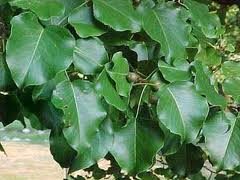|
 Column Column
Ornamental Pear Trees, Mushrooms and
Toadstools in the Lawn, and Rhubarb Reminders
By John Fulton
 Send a link to a friend
Send a link to a friend
[July 12, 2014]
Ornamental Pear Trees -When you
bought your ornamental pear tree, you probably thought it was a
sterile tree (having no fruit). You were right at the time, but some
things have changed. The original Bradford pear tree was sterile. It
is actually a member of the Callery pear group. Due to many of the
trees breaking at the graft, new varieties of the sterile,
ornamental pear were introduced from the Callery group. The problem
was, these different varieties cross pollinate. This means fruit
forms on the formerly sterile pear tree. This feature has lead to
the pear trees as being classified as invasive by many
municipalities. Don’t fret though – Kentucky bluegrass and some
others are also on those lists!
|
|
 These pear trees have many beneficial aspects such as spring
blooming, shape, relatively free of pest damage, and fall
foliage color turning to red. Also the shape is great, but that
shape also leads to weak branch angles causing breakage in
storms. Another down-side to the Callery pear is their
relatively short life, with decline often setting in between 20
and 30 years of age. There is also the fire blight issue we’ve
had the past several years. I’m just pointing out the pluses and
minuses of the tree, rather than passing any judgment. If you
are in the process of selecting or replacing a tree, you might
check out the Extension website at http://urbanext.illinois.edu/treeselector/
for information on trees. These pear trees have many beneficial aspects such as spring
blooming, shape, relatively free of pest damage, and fall
foliage color turning to red. Also the shape is great, but that
shape also leads to weak branch angles causing breakage in
storms. Another down-side to the Callery pear is their
relatively short life, with decline often setting in between 20
and 30 years of age. There is also the fire blight issue we’ve
had the past several years. I’m just pointing out the pluses and
minuses of the tree, rather than passing any judgment. If you
are in the process of selecting or replacing a tree, you might
check out the Extension website at http://urbanext.illinois.edu/treeselector/
for information on trees.

Mushrooms and Toadstools in the Lawn
The symptoms of “fairy rings” have been classic this year. Dark
green grass in rings that looks like a target pattern is a
symptom of fairy rings. Fairy rings are visible now. Fairy rings
are caused by a fungus that is in the soil. Actually there are
about 50 fungi that can cause fairy rings. These fungi feed on
decaying organic matter such as large roots from trees that were
in the area, or from buried lumber. The dark green circle part
of the equation comes from extra nitrogen that becomes available
as the organic matter is broken down by the fungus. There is
also a portion of dead grass in the center of the green streaks
this year. It will fill in eventually.
Some prevention will help keep the problem from occurring.
Simply removing stumps and large roots, and not burying lumber
help prevent this type of problem. As for a cure, fungicide
drenches have been successful on a very limited basis. Removal
of the fungus usually involves simply mowing it off when you mow
the lawn, or breaking it off with a garden rake and removing.
One option to mask the symptoms of the dark rings is to
fertilize the surrounding grass with a high-nitrogen fertilizer
to make that grass green also.
[to top of second column] |

Rhubarb Reminders
As we are in the heat of the summer, here are a few reminders
about rhubarb. The first year of establishment, you shouldn’t
harvest at all. The second year you can have one or two weeks of
harvest. After the second year, you can harvest eight to ten
weeks. Pull the stalks, and don’t remove more than a third at
any one time. The old adage of “don’t harvest in any month with
an “r” in it is also good advice.
The appearance of seedstalks is a common problem. This tends to
happen with cheaper plants grown from seed, overcrowding, plants
that have begun declining and need to be divided and re-planted,
or plants suffering from low fertility. When seedstalks do
appear, simply cut them off at the base of the plant. The
production of seedstalks tends to make the leaves and petioles
smaller.
[By JOHN FULTON, COUNTY EXTENSION
DIRECTOR SERVING LOGAN, MENARD, AND SANGAMON COUNTIES]
 |